UC picks Richmond for Lawrence Berkeley lab campus
Carolyn Jones, Chronicle Staff Writer
Tuesday, January 24, 2012
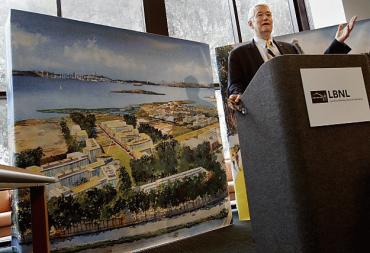

Brant Ward / The Chronicle
UC Berkeley Chancellor Robert Birgeneau speaks in front of an artist's rendering of the planned Lawrence Berkeley National Laboratory campus in Richmond.
Images



 View All Images (4)
View All Images (4)
Related Content

UC selects Richmond site for new lab campus
Lawrence Berkeley Laboratory has chosen to build its new research facility on the Richmond shoreline, a move that could rank the city with Livermore and Berkeley as a new hub for scientific innovation.
The lab's new campus will bring in more than 800 jobs, attract spin-off enterprises and generate millions of dollars in tax revenue that could transform the city of 100,000 residents.
"This is a magnificent day for the citizens of Richmond," said Rep. George Miller, D-Martinez. "The next generation of scientific discoveries and economic growth will be right here. This is as exciting as it can possibly be."
Lab officials announced a year ago they wanted to consolidate their off-site research labs, which are scattered throughout the East Bay, into one space to save money and to promote collaboration among researchers.
Twenty cities and developers submitted applications to host the new campus. Last year the lab winnowed the field to six finalists.
Those cities launched enthusiastic public campaigns to woo the lab in hopes of landing thousands of high-paying science jobs at the lab and related businesses. Alameda, in particular, was eager to snag the lab for the former Naval Air Station, which has been sitting mostly vacant since the Navy left in the 1990s.
Beat 5 other finalists
"We're disappointed, but it's not a death blow," said Alameda City Manager John Russo. "I truly think we would have been the best choice, but overall I think the process was fair. Kudos to Richmond."
Partly because it was a leading contender for the lab, Alameda was able to obtain the former base from the Navy for free last year, saving the city about $108 million in conveyance costs, Russo said.
Richmond was chosen over Alameda, Berkeley, Oakland, Emeryville and Albany.
Richmond's winning pitch was based on its relative proximity to the lab's main campus in the Berkeley hills, its plethora of adjacent open space that can be developed for future expansion and city officials' eagerness to accommodate lab plans, lab officials said.
Another major advantage is that the University of California, which oversees the lab, already owns the property. The new campus will be built at UC's Richmond Field Station, a smattering of labs and offices at the scenic, southern end of the Richmond waterfront.
2016 opening
The site is surrounded by eucalyptus trees, with the Bay Trail winding along the shore and plenty of geese, turkeys, egrets and other wildlife.
The new campus will focus on cancer and health, environment and energy research. It's expected to open in 2016.
The funding will come from a mix of public and private bonds, as well as state and federal investment.
The new campus will be a major leap forward for the lab, which was founded in 1931 by Nobel physicist Ernest Lawrence.
"This new campus will ensure that the next century of the Lawrence Berkeley Laboratory will be just as bright as the first," said lab Director Paul Alivisatos.
In Richmond, the lab will join a slew of other recent milestones, including the opening of SunPower's solar panel factory and Rosie the Riveter National Historical Park.
"The lab is huge, but there's a lot happening here generally," City Councilman Tom Butt said. "The city's been heading in this positive direction for a while now."
E-mail Carolyn Jones at carolynjones@sfchronicle.com.
This article appeared on page A - 1 of the San Francisco Chronicle
Read more: http://www.sfgate.com/cgi-bin/article.cgi?f=/c/a/2012/01/23/BAJE1MT8S9.DTL#ixzz1kO6dYJh2

Lab choice may prove beneficial to Berkeley in long term
January 23, 2012 2:30 pm by Berkeleyside Editors
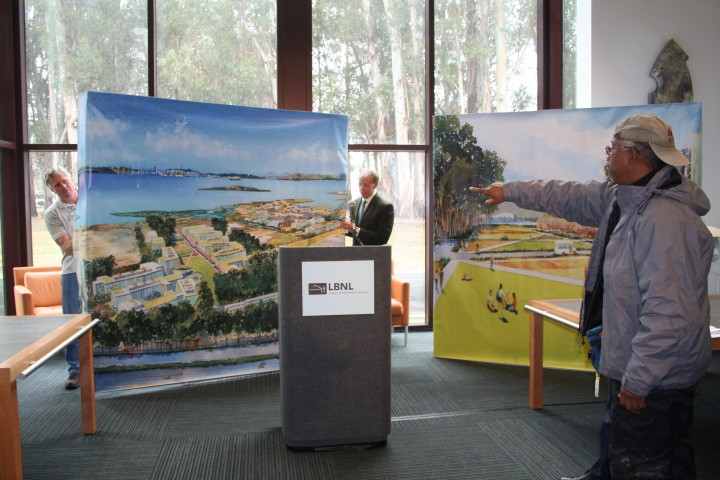
Officials ready for the press conference announcing Richmond as the new site for the second campus of LBNL. Photo: Frances Dinkelspiel
By Lance Knobel and Frances Dinkelspiel
In late September and early October, Dr. Jeff Ritterman, a member of the Richmond City Council, went down to Berkeley West Biocenter on Potter Street, one of the divisions of Lawrence Berkeley National Lab. Both times, Dr. Ritterman arrived before 8 am and staked out a spot in front of the entrance. As scientists came to work, Dr. Ritterman handed them a 4×6 postcard with a picture of the Richmond shoreline, signed by a resident of that city. It was a pitch for placing LBNL’s second campus in Richmond.
“I knew the decision would be important to (lab) employees,” said Dr. Ritterman, who served as head of cardiology at Kaiser Richmond for 30 years and became a city councilman in 2009. “I knew people had some concerns about Richmond and I wanted to reassure them and make an extra effort.”
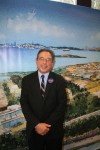
Dr. Jeff Ritterman, a member of the Richmond City Council
While Dr. Ritterman’s outreach efforts were only a small part of the city’s pitch to lure Berkeley Lab to town, it was emblematic of the city’s enthusiasm. On Monday, at a press conference in Richmond packed with lab officials, city employees, a Congressman, a state senator, the UC Berkeley Chancellor and other dignitaries, it became official: the second campus of the LBNL will be in Richmond. The city beat out Berkeley, Oakland, Emeryville, and Alameda.
Richmond’s eagerness for the second campus apparently played an important role in the city’s selection. Speaker after speaker mentioned the huge crowds that attended the information sessions or expressed their support in other ways.
“An outstanding show of community support occurred in Richmond,” said Paul Alivisatos, the director of the lab.
UC Berkeley already owns the 120-acre Richmond Field Station where the second campus will be located. It also became clear during the press conference that the ability to build even more structures on this site in the future, and create a de facto additional campus for Cal, played a large role in the site’s selection.
“We’ve had a long time presence here,” said Chancellor Robert Birgeneau. “Now with the addition of the Lawrence Berkeley Lab to the site, it will make a critical mass and this will make this the premier research center not just in the region, or the state, but the world.”
Cal has been “space limited in the city of Berkeley,” and the difficulty in expanding has meant the university has lost out on some important international endeavors, such as a solar observatory, said Birgeneau. Lots of countries, including China and Japan, want to partner with Cal, but have been constrained by space. Now they will be able to set up shop on the Richmond campus.
“Instead of exporting jobs we will be importing jobs,” he said.
While Richmond city officials were gleeful on Monday, the mood was more subdued in Berkeley. The announcement this morning that Richmond Field Station had been chosen for the Lawrence Berkeley National Laboratory second campus disappointed many who had been pushing one of the three Berkeley-related sites, but it wasn’t completely unexpected. And several senior officials also believe the decision may prove beneficial to Berkeley in the long run.
“We’re disappointed, but not surprised,” said Michael Caplan, Economic Development Manager for Berkeley. “We had been hopeful that they might choose a site closer to their main campus, which would have favored one of the three Berkeley sites. But we knew cost was a factor.”
Mayor Tom Bates said: “Richmond Field Station is an excellent site and I’m very happy for them. Now we can look forward to spin-off businesses from the Lab, with product ideas that are ready to go to market, coming to West Berkeley,” he said. “Some mayors might be parochial, but I take the view that we all benefit from this,” Bates said, citing the Green Corridor initiative which aims to create a thriving green technology area in the East Bay.
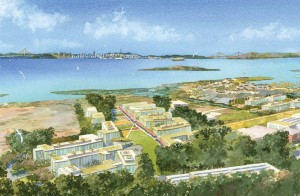
Design for the Richmond Field Station campus
RFS is already owned by the University of California, which operates Berkeley Lab for the Department of Energy. When the Request for Qualifications (RFQ) seeking new sites was issued last January, the Richmond Field Station was clearly set as the benchmark for other sites: “RFS by and large meets the parameters of the Site Attributes,” it stated. “Respondents to this RFQ should know that the University may choose to site the second campus at RFS and will be evaluating potential sites relative to their ability to better meet the needs of the University and the DOE.”
The Berkeley Lab’s second campus will unify a number of facilities that are scattered around the East Bay, such as the Joint Bio-Energy Institute in Emeryville, the Joint Genome Institute in Walnut Creek, the National Energy Research Scientific Computing Center in Oakland, and the life sciences division of the Lab, which is currently on Potter Street in West Berkeley. The second campus is anticipated to eventually have 2 million gross square feet of facilities.
When rival sites made community presentations last summer, potential negatives of the Richmond site were regularly highlighted. Photos showed cars bumper-to-bumper on I-80, making the Lab’s announced desire for sub-20-minute commutes between the two campuses unlikely. Berkeley pitches highlighted the many restaurants and stores a walk or a short drive away from their projects, on the assumption that researchers would be lured out of their labs at lunchtime.
In the end, however, those arguments paled beside the cost and time advantages presented by Richmond.
“I’m surprised,” said Michael Goldin, one of the developers of the Aquatic Park West site which was on the shortlist. “I couldn’t see why they went through the trouble of an RFQ if Richmond was a real possibility.”
Goldin said, however, that he thought the year-long process, including the public presentations, could have concrete benefits for Berkeley and for the region.
“There was a lot of goodwill that came out of the process,” he said. “People from the outside needed to know that things are changing.”
Goldin’s view was echoed by Caplan at the city. “The process itself seems to have highlighted Berkeley as a center for bioscience research,” he said. “The benefits of a growing bioscience and energy research base [with the Richmond choice] will accrue to the entire region.”
Mayor Bates also pointed out what he saw as at least two liabilities to having the Lab’s second campus in Berkeley: the property is off the tax roll and, had the campus come here, there would not have been much private land available for ancillary businesses that emerged from the lab.
In all, Bates said it was a “win win” situation.
The work to design, finance, and build a second campus will now begin in earnest. University officials will start a thorough environmental review of the site, which is located right near Interstate 580 on Seaver Street, off of Meade Street. They hope to be moving in in 2016.
Related:
Berkeley Lab chooses Richmond for second campus [01.23.12]
Lab picks Richmond Field Station for a second campus
By Carol Ness, NewsCenter | January 23, 2012
BERKELEY —
The Lawrence Berkeley National Laboratory, bursting at the seams of its home next door to UC Berkeley, announced Monday that it has picked the University of California’s bayside Richmond Field Station as the site of its second campus.
At a press conference at the station, crowded with jubilant City of Richmond officials wearing blue-and-gold “Richmond Heart LBNL” buttons, lab director Paul Alivisatos said Richmond was selected over five other finalists, including Oakland and Berkeley, because it had the “strongest combination of attributes” to meet the lab’s needs into the future — including the possibility for a renewed and deeper partnership with UC Berkeley.
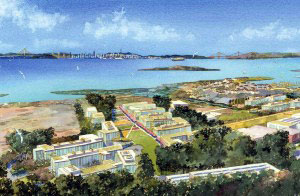 A second campus will allow the Berkeley Lab to bring together its biosciences programs and their 800-plus employees — about 20 percent of the lab’s total — currently operating out of leased spaces around the Bay Area. They include the Joint BioEnergy Institute, now in Emeryville, and the Joint Genome Institute, in Walnut Creek. A second campus will allow researchers to “achieve a lot more synergy in their science” as well as providing for future lab growth, Alivisatos said.
A second campus will allow the Berkeley Lab to bring together its biosciences programs and their 800-plus employees — about 20 percent of the lab’s total — currently operating out of leased spaces around the Bay Area. They include the Joint BioEnergy Institute, now in Emeryville, and the Joint Genome Institute, in Walnut Creek. A second campus will allow researchers to “achieve a lot more synergy in their science” as well as providing for future lab growth, Alivisatos said.
Berkeley Chancellor Robert Birgeneau said the campus, which already conducts transportation and seismic research at the Richmond site, enjoys a “helpful, symbiotic partnership with the City of Richmond” and looks forward to developing that further.
“Now, with the addition of the Lawrence Berkeley Lab to the site, we will certainly achieve a critical mass that will make us one of the premier research centers — not just in this county nor in this state but in this country as a whole,” he said. In a message to the campus, he expanded on the theme, saying, “This new ‘ecosystem’ of research and innovation will provide space and resources for the development of incubators and start-ups that can help speed the translation of research discoveries into goods and services that will directly benefit people around the world.”
Birgeneau told the press conference that the expanded research presence at the 152-acre Richmond site will allow UC Berkeley to better compete for new federal programs: “Here at the Richmond Field Station, we think we have new possibilities which will open up doors for us that have been closed up to this point.”
The selection will enhance the “longtime, extraordinary history of partnership between the University of California at Berkeley and Lawrence Berkeley Laboratory,” he added. More than 200 campus professors have appointments at the lab, he said — he himself is a professor of physics and lab staffer, and Alivisatos is a chemistry professor at Berkeley as well as directing the lab. And more than 1,000 students a year get research training there, he said. A second campus at Richmond will let that work expand.
Elected officials representing Richmond, from Rep. George Miller to Mayor Gayle McLaughlin, City Manager Bill Lindsay and all five members of the Richmond City Council, crowded the room and heightened the celebratory mood.
The lab is envisioned as a sort of Mission Bay for the East Bay, a gleaming new bayside research center that will generate jobs both in the short and long term, and will encourage development and innovative startups in the economically struggling areas all around it.
“It’s just a magnificent day,” said Miller.
“It’s not only the jobs that will be created in the Bay Area,” he said. “It’s also about a signal that this nation is getting ready once again to make this kind of basic investment in research. It is that research that is really the only sustainable source of economic growth — it leads to the innovation, it leads to the jobs.”
Alivisatos said the selection process deepened the lab’s connections with all the East Bay communities competing for the campus. One message that came through loud and clear, he said, was that “they want their leaders to place a greater emphasis on science education, because that is seen broadly throughout the East Bay as a key to our future.” As a result, the lab will redouble its efforts to build partnerships with East Bay communities, he said.
Site selection kicks off a long process of planning and environmental review, both of which will invite public participation and comment, as well as the effort to secure financing, Alivisatos emphasized.
“It’s just the beginning of a journey,” he said, adding later: “I’m optimistic we’ll be back here in 2016 opening the doors to the campus, and it’s going to be very exciting.”
Contra Costa Times editorial: New lab campus will help Richmond and all of the East Bay
Contra Costa Times editorial
© Copyright 2011, Bay Area News Group
Posted: 01/23/2012 04:00:00 PM PST
Updated: 01/23/2012 04:19:32 PM PST
Once finalists were selected as possible sites for the second campus of the Lawrence Berkeley National Laboratory, the East Bay could not lose because all three choices were here.
On Monday, officials announced that Richmond would get the new campus. To be sure, officials in Oakland and Alameda are disappointed, but they should take some comfort in being competitive bidders.
The new site is at the Richmond Field Station near Richmond Inner Harbor. It will accommodate 800 workers who have been orphaned from the lab's Berkeley hills facility to off-site locations as well as allowing for future growth.
The lab has employed 12 Nobel laureates and worked on projects such as the discovery of dark energy and the chemical laser, as well as mapping of the universe.
We hope that winning the bid serves as an object lesson for Richmond about what can happen when people unite behind a cause.
Richmond is a city with deep political divides that can sometimes hinder progress, but the community came together on this project like it had not in recent memory. City Manager Bill Lindsay said that Richmond residents provided "the warm welcome mat that was undoubtedly a major factor in their decision."
The new campus is expected to generate more than $200 million in spending impacts to Richmond, which city leaders claim is on the cusp of an economic renaissance.
We certainly hope that is true because a resurgent Richmond would be very good news for all of the East Bay.
UC picks Richmond for Berkeley lab's 2nd campus
Updated at 02:22 PM today
Tags:
RICHMOND, Calif. -- The University of California announced Monday that it has chosen a site in Richmond as the preferred home for a second campus of the Lawrence Berkeley National Laboratory, which the university manages
The Richmond Field Station, which is owned by the university, beat out five other East Bay locations that had been vying to house the second campus, which is expected to create jobs and bring in local revenue.
The site is located on Seaver Avenue, off of Meade Street, near Interstate Highway 580.
Most of the Berkeley Lab's 4,200 employees work at the lab's main facility in the Berkeley hills, but about 20 percent of them work at leased facilities scattered around the East Bay. Lab officials have said a second campus would save money by consolidating those facilities.
More than 20 cities and developers proposed locations for the second campus, and university officials narrowed the proposals down to six finalists last year.
The finalists were the Richmond site; Alameda Point in Alameda; Aquatic Park West in Berkeley; Brooklyn Basin in Oakland; properties in Emeryville and West Berkeley that are currently occupied by the lab; and Golden Gate Fields.
University officials say construction of the second campus will take about four years, and that they hope to move researchers into the new site by mid-2016.
Berkeley Lab Director Paul Alivisatos said in a statement, "Each city, community, and their developer partners presented extremely thoughtful and well-formulated proposals for us to consider, for which we are deeply grateful."
Alivisatos said, "While we can only pick one site, we hope that the new relationships we've made will continue to help us foster excitement in science. The enthusiasm is wonderful affirmation of the desire of the entire East Bay to be part of developing scientific solutions to some of the greatest challenges facing our society."
Richmond City Manager Bill Lindsay called the announcement a "great bit of news."
He released a statement thanking the Richmond City Council, city employees, and the Richmond community for "providing the warm welcome mat that was undoubtedly a major factor in their decision."
Congressman George Miller, D-Martinez, said in a statement Monday morning he is "thrilled" by the lab's decision.
"This is the decision we were hoping for, and it is the right decision for the Lab, for Richmond, and for the East Bay," Miller said.
He said, "The Berkeley Lab's announcement that its second campus will be built in Richmond means new jobs for our community now and in the long term, new educational opportunities for our students, and more innovations and new discoveries for our country."
(Copyright 2012 by Bay City News, Inc. Republication, re-transmission or reuse without the express written consent of Bay City News, Inc. Is prohibited.)









 A second campus will allow the Berkeley Lab to bring together its biosciences programs and their 800-plus employees — about 20 percent of the lab’s total — currently operating out of leased spaces around the Bay Area. They include the Joint BioEnergy Institute, now in Emeryville, and the Joint Genome Institute, in Walnut Creek. A second campus will allow researchers to “achieve a lot more synergy in their science” as well as providing for future lab growth, Alivisatos said.
A second campus will allow the Berkeley Lab to bring together its biosciences programs and their 800-plus employees — about 20 percent of the lab’s total — currently operating out of leased spaces around the Bay Area. They include the Joint BioEnergy Institute, now in Emeryville, and the Joint Genome Institute, in Walnut Creek. A second campus will allow researchers to “achieve a lot more synergy in their science” as well as providing for future lab growth, Alivisatos said.